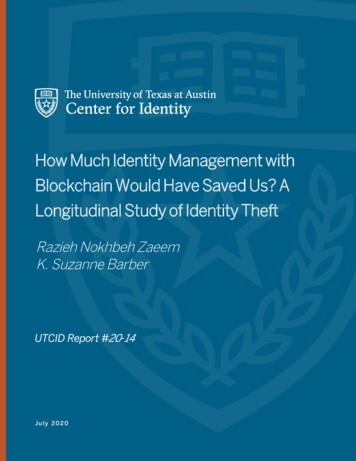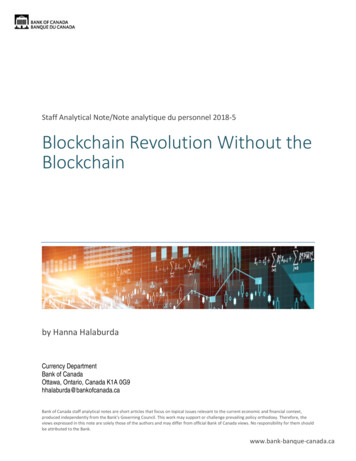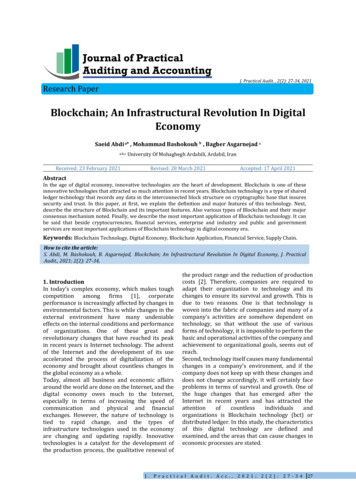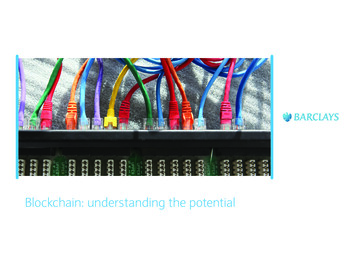
Transcription
Blockchain TutorialBlockchain Explained through Bitcoin1 Blockchain - IntroductionIn recent years, there is a lot of buzz on Blockchain. Many have described this as a mostdisruptive technology of the decade. Especially, the financial markets could be the most affectedones. The technology is being adapted into many verticals like Healthcare, Medicines,Insurance, Smart Properties, Automobiles, and even Governments. However, so far the mostsuccessful implementation of Blockchain is the Bitcoin - A Peer-to-Peer Electronic CashSystem, which incidentally is also the first implementation of blockchain technology. Thus, tounderstand blockchain technology, it is best to understand how Bitcoin System is designed andimplemented.In this article, you will learn what is Blockchain, its architecture, how it is implemented and itsvarious features. I will site Bitcoin implementation while describing the intricacies of blockchain.The blockchain architecture is not so trivial and many have written good articles, tutorialsincluding several videos. These range audience from Novice to Professionals. In this tutorial, Iwill focus on the conceptual understanding of blockchain architecture, keeping both Novice andProfessionals on mind. Before delving into the blockchain, it is important to know why the needfor this new technology emerged? The answer to this question lies in what is known as DoubleSpending.2 Blockchain - Double-SpendingConsider a situation shown in Figure 1:Figure 1
As clearly seen here, Bob is tendering a 10 bill to Lisa in exchange of a book. Once the Lisareceives this physical 10 bill, there is no way for Bob to re-use this money for some othertransaction, as the physical currency is now in Lisa’s possession.Now, consider a situation where the money is paid in Digital form. This is illustrated in Figure 2:Figure 2As the format for money exchange is in the digital format, it is essentially a binary physical filestored somewhere on Bob’s device. After Bob gives this file (digital money) to Lisa, he can alsoa give a copy of the file to Alice. Both now think that they have received the money withouthaving any means of authenticating the digital coin and would thus deliver their respectivegoods to Bob. This is called double-spending where the sender spends the same money atmore than one place for obtaining services or goods from multiple vendors.To solve this problem of double-spending, one would employ a centralized authority to monitorall the transactions. This is illustrated in Figure 3:
Figure 3The centralized authority, which in common terms is your bank, maintains a ledger bookrecording all the transactions. Now, Bob has to send his digital money to the bank who wouldmake an entry into its ledger debiting Bob’s account. After ensuring that Bob has sufficientbalance to pay for the digital money which he wants to send, would send the money to Lisacrediting her account in its ledger. Now, it is guaranteed that Bob cannot double spend themoney. If every digital transaction is routed through a centralized authority like this, the problemof double-spending would be solved. This also provides another benefit in validating theauthenticity of each coin (digital money) that it receives in the transaction. So the fake money(duplicate money as in the case of Bob paying to Alice using a copy) would be easily detectedand prevented from the circulation.The introduction of centralized authority though it solves the double-spending problem,introduces another major issue - the cost of creating and maintaining the centralized authorityitself. As the banks need money for their operations, they start cutting commissions on eachcurrency transaction they do for their clients. This sometimes can become very expensive,especially in overseas transfer of money where multiple agents (banks) may be involved in theentire deal.All the above issues are solved by the introduction of digital currency, called Bitcoin. I will nowgive you a brief background on what Bitcoin is before delving into its design and architecture.3 Bitcoin - Brief HistoryThe Bitcoin was introduced in this world by Satoshi Nakamoto through a research-style whitepaper entitled Bitcoin: A Peer-to-Peer Electronic Cash System in the year 2008. The Bitcoin notonly solved the double-spending problem, but also offered many more advantages, One suchadvantage worth mentioning here is the anonymity in the transactions. Satoshi who created thesystem and did transact few coins on this system is totally anonymous to the entire world. Justimagine, in this world of social media, when the privacy of each individual is at stake, the worldis not able to trace out so far who is Satoshi? In fact, we do not know whether Satoshi is an
individual or a group of people. Googling it out also revealed the fact that the bitcoins SatoshiNakamoto holds is worth about 19.4 billion - that money now remains unclaimed in the Bitcoinsystem. So what is Bitcoin - let us have a look!What is Bitcoin?As you saw earlier, the bank maintains a ledger recording each transaction. This ledger isprivately held and maintained by the bank. Satoshi proposed that let this ledger be public andmaintained by the community. The moment you make such a ledger public, severalconsiderations would come to your mind. This ledger has to be tamper-proof so that nobody canmodify its entries. As each entry in the ledger is publicly visible, we will have to figure out how tomaintain the anonymity - obviously you would not like everybody in the world to know that I paidyou one million dollars. Also, as there is only one single ledger keeping track of each and everytransaction in the world, the size of ledger would be another great concern. Providing a solutionto these intricacies was not trivial and that’s what I am attempting it here to make youunderstand underlying architecture of Bitcoin in simple words. This underlying architecture is theBlockchain and that’s what this tutorial is about. To understand the Blockchain architecture,you need to understand a few key features on which it is based on. So, let us get started withPKI - Public Key Cryptography.4 Blockchain - Public Key CryptographyPublic Key Cryptography or in short PKI is also known as asymmetric cryptography. It uses twopairs of keys - public and private. A key is a some long binary number. The public key isdistributed worldwide and is truly public as its name suggests. The private key is to be strictlyheld private and one should never lose it. In case of Bitcoin, if you ever lose the private key toyour Bitcoin wallet, the entire contents of your wallets would be instantly vulnerable to theft andbefore you know it, all your money (the contents of your wallet) would be gone with nomechanism in the system to trace out who stole it - that is the anonymity in the system that Imentioned earlier.The PKI accomplies two functions - authentication and the message privacy throughencryption/decryption mechanism. I will now explain both these functions:AuthenticationWhen the two parties exchange messages, it is important to establish a trust between thesender and the receiver. Especially, the receiver must trust the source of message. Going to ourearlier scenario (depicted in Figure 1) of Bob sending some money to Lisa for purchasing ofsome goods from her, let us see how the PKI builds this trust between Bob and Lisa. Look atFigure 4:
Figure 4In the first place, if Bob wants to send some money to Lisa, he has to create a private/public keyof its own. Note that both keys are always paired together and you can not mix the private andpublic keys of different individuals or different instances. Now, Bob says that he is sending 10to Lisa. So he creates a message (a plain-text message) containing Bob’s (sender) public key,Lisa’s (receiver) public key, and the amount ( 10). The purpose of this remittance such as “Iwant to buy pumpkin from you” is also added into the message. The entire message is nowsigned using Bob’s private key. When Lisa receives this message, she will use the signatureverification algorithm of PKI and Bob’s public key to ensure that the message indeed originatedfrom Bob. How the PKI works is beyond the scope of this tutorial. The interested reader isreferred to this site for a more detailed discussion on PKI. This establishes the authenticity ofthe message originator. Now, let us look at the message privacy.Message PrivacyNow, as Lisa has received her payment, she wants to send the link to her ebook which Bobwants to buy. So Lisa would create a message and send it to Bob as shown in Figure 5:Figure 5
The Lisa creates a message such as “Here is the link to my ebook which you had requested”,signs it with Bob’s public key that she has received in Bob’s request message and also encryptsthe message using some secret key which is shared between the two during HTTPShandshake. Now, Lisa is sure that only Bob can decode the message using the private key thatis held by Bob alone. Also, somebody intercepting the message would not be able to recover itscontents because the contents are encrypted by a secret key held only by Bob and Alice. Thisguarantees to Lisa that access to her ebook is granted only to Bob.Having seen both the features, Authentication and Message Privacy, implied by PKI, let usmove ahead to see how Bitcoin makes use of PKI to secure the public ledger that I mentioned inthe chapter “What is Bitcoin?”.For your knowledge: The most popular PKI algorithms are RSA and ECDSA, Bitcoin uses thelatter one.5 Blockchain - HashingOne of the most important function in PKI is the hashing function. A hash function maps thedata of any arbitrary size to data of fixed size. Bitcoin uses SHA-256 hash function thatproduces a hash (output) of size 256 bits (32 bytes). This is illustrated in Figure 6:Figure 6
Bob, while placing an order with Lisa, creates a message similar to the one shown above. Thismessage is hashed through a hash function that produces a 32 byte hash. The beauty of thishash is for all practical purposes the hash (the 256-bit number) is considered unique for thecontents of the message. If the message is modified, the hash value will change. Not only thatgiven a hash value, it is impossible to reconstruct the original message.After having seen the importance of hashing, let us move on another concept in Bitcoin that ismining.6 Bitcoin - MiningWhen Bob creates a purchase request for Lisa, he does not send it to Lisa alone. Rather therequest message is broadcasted on the entire network to which he is connected. Bob’s networkis depicted in Figure 7.Figure 7The message goes to all the connected nodes (machines). Some of the nodes in the diagramare marked as miners. These are the machines which run a piece of software for mining thebitcoin message. I will now explain you what this mining means.
Mining ProcessAs the entire network is widely distributed, every miner in the network is expected to receivemultiple messages from multiple vendors at any given period of time. What the miner does is hecombines these messages in a single block. This is illustrated in Figure 8:Figure 8After a block of messages is formed, the miner creates a hash on the block using the hashingfunction described earlier. Now, as you know if any third party modifies the contents of thisblock, its hash would become invalid. Incidentally, each message is time-stamped so thatnobody can modify its chronological order without affecting the block’s hash value. Thus, themessages in the block are perfectly secured from tampering. How this fact is used in securingall the transactions in the network is explained further.7 Blockchain - Chaining BlocksThe blocks created by various miners are chained together to form what is known as a trulydistributed public ledger. This is illustrated in Figure 9:
Figure 9Each block in the chain contains multiple messages (transactions) as seen earlier in Figure 8. Ablock in the chain may come from any miner. While creating the chain of blocks, we observe therule that hash of the previous block is added to the current block. Thus, a miner while creatingthe block, picks up the hash of the last block in the chain, combines it with its own set ofmessages and creates a hash for its newly created block. This newly created block nowbecomes the new end for the chain and thus the chain keeps on growing as more and moreblocks are added to it by the miners.8 Blockchain - Proof-of-WorkAs all transactions are time stamped, we need to implement a distributed timestamp server on apeer-to-peer network. This requires some additional implementation and that is the Proof-ofWork that I will describe now. To each block, we now add one more item called Nonce asshown in the figure below:
Nonce is a number such that the block’s hash meets a certain criterion. This criterion could bethat the generated hash must have its leading four digits to be zero. Thus, the generated hashwould look like 000010101010xxx. Generally, the miner starts with a Nonce value of 0 andkeeps on incrementing it until the generated hash meets the specified criterion. Note that thehash generation works at random and is beyond your control - that is you cannot force the hashfunction to generate a certain hash. Thus, it may take several iterations until the desired hashwith four leading zeros is generated. The expected time for generating a block in bitcoin systemis 10 minutes. Once the miner successfully mines the block, he releases that in the systemmaking it now the last block in the chain.Note that there are multiple miners competing to generate the legitimate block. The Bitcoinsystem awards the first successful miner by giving him certain bitcoins. In general, the minerwith more computing power may be an early winner. This can cause attacks on the entiresystem by those who possess a huge processing power. I will describe the attacks and howthese are mitigated towards the end of this tutorial.
9 Bitcoin - Network & MiningI will now summarize the steps described above; this is what happens in the network:1. Anybody who wants to obtain services from the third party who has advertised on thenetwork first creates a transaction (message to the desired recipient).2. Over a given period of time, there could be many senders (buyers) and receivers(sellers) creating such transactions.3. All transactions are broadcast on the network to all nodes. Note that it is not necessarythat a given transaction must reach each and every other node in the network.4. Each node assembles the new transactions into a block. Note that the set oftransactions in each block is independent of the set in blocks created by others and willnaturally be different than others. This does not matter; the system ensures that everytransaction broadcast on the network gets included in some block over a reasonableamount of time. Generally, the sender will incentivize the node by offering a certainamount of bitcoins to the miner for its efforts. The miner may opt for giving priority forinclusion in the block to those with higher incentives,5. The node now works on finding the proof-of-work for its assembled block.6. When the node finds a proof-of-work, it broadcasts the assembled block on the network.7. The nodes that receive the new block will accept it only after verifying that alltransactions in the block are valid and not already spent.8. If the block is accepted as valid, the node which is working on its own new block willhave to re-assemble the transactions in its block ensuring that the transactions are notduplicated. The node now works on finding the proof-of-work on its newly created block;while doing so it will take the hash of the accepted block as the previous hash.9. Likewise, the blockchain continues growing for ever.Now, as we have seen how the entire system works, let me describe some of the side effectsand how to resolve them.10 Blockchain - Incentives to MinersAs we saw in the chapter Bitcoin - Mining, a miner may be flooded with many transactions atany given period of time. The maximum size for a block is pre-defined in the systemnecessitating that only a certain number of transactions be included in the block. The number oftransactions in the block is determined by the pre-defined block size and the average length ofeach block. An important tip here is that the sender should not include too much information inits message so as to make it short and thereby incentivizing the miner to accept it before theother lengthy messages. A sender generally will also add a transaction fee in terms of a certainnumber of bitcoins so as to incentivize the miner for early inclusion in his block.The other consequence in building the blockchain is its mere size. Over a period of time, theentire blockchain may become too large for a node to store it on its disk. This is solved by usingMerkle Tree which is described next:
11 Blockchain - Merkle TreeThe issue of disk space in a node is easily overcome because all transactions in a block arehashed in a Merkle Tree as shown in Figure 10:Figure 10The block header now contains the hash of the previous block, a Nonce, and the Root Hash ofall the transactions in the current block in a Merkle Tree. As this Root Hash includes the hashesof all the transactions within the block, these transactions may be pruned to save the diskspace. So now your blockchain will look like Figure 11:Figure 11
This can result in a lots of saving in the disk space. This strategy is used by a normal client whois interested in just receiving payments from others. However, the miners need to save the fullblockchain. Now the question arises, how a receiver verifies the payment without having theability to trace a received coin right to its origin. This is explained next:12 Blockchain - Payment VerificationConsider a case whereby as a vendor you may like to verify a certain payment made in thepast. As the blockchain you are holding on your machine contains only the block headers asshown in the earlier figure, the transaction that you are searching for is missing in the copy ofyour blockchain. You can now search backwards in your copy of the blockchain until you find ablock in which the desired transaction is timestamped in. Now, request the merkle tree of theselected block and you will have the transaction that you are looking for. This is illustrated inFigure 12:Figure 12Here, we assume that you are looking for Tx103. Though you may not be able to see thecontents of Tx103, you know that this has been accepted by the block to which it belongs andall subsequent blocks in the chain. Thus, you can safely trust this transaction and proceed withyour business.
14 Blockchain - Resolving ConflictsAs we have seen the Bitcoin network contains several miners. It is possible, that the twodifferent miners solve the Proof-of-Work at the same time and thus add their blocks to the lastknown block in the chain. This is illustrated in Figure 13:Figure 13Now, we have two branches after Block 3. Both the branches are valid. So the next mined blockmay be added in either of the branches. Suppose, the miner adds the newly mined block toBlock 104-A, the branch containing Block 104-A will be longer than the branch containing Block104-B. This is illustrated in Figure 14:Figure 14In Bitcoin architecture, the longest branch always wins and the shorter ones are purged. So theBlock 104-B has to be purged. Before purging this block, all transactions in this block will bereturned to the transaction pool so that they are mined and added to some future block. This ishow the conflicts are resolved and only one single chain of blocks is maintained by the system.15 Blockchain - PrivacyAs the ledger which is recording all the bitcoin transactions is made truly public, the privacy is atstake. Anybody in the world would be able to know who paid whom? The traditional bankingsystem is able to maintain this kind of privacy by keeping its records confidential. Privacy inBitcoin system is achieved by a different strategy. Note that we said that the sender of a bitcoin
needs to know whom to pay. So he asks for the public key of the vendor to which he desires tomake the payment. This public key can be anonymous. In the sense, as a vendor of someservices, when somebody asks you where to send the payment, you would simply send himyour public key. The association of this public key with you is not recorded anywhere in theledger. That way anybody outside of this transaction would only know how much money istransacted and to which public key the money is paid out. To achieve a higher degree ofprivacy, for every transaction, you may generate a new private/public key for each transactionso that multiple transactions made by you cannot be grouped together by a third party. For anoutsider, this would simply mean that multiple transactions of smaller values were made andthey will never will be linked to a common source.Lastly, any online internet based system is vulnerable to abuses. I will now describe fewpossible types of attacks on Bitcoin system and how those are mitigated.16 Bitcoin - Mitigating AttacksI will discuss three different types of probable attacks in the Bitcoin system:Race AttackAs an attacker, you may send the same coin to different vendors in rapid succession, probablyby using two different machines. If the vendors do not wait for the block confirmation beforedelivering the goods, they will very soon realize that the transaction was rejected during themining process. The solution to this kind of attack is that the vendor must wait for at least oneblock confirmation before sending out the goods.Finney AttackIn this case, the attacker is the miner. The miner mines a block with his transaction and doesnot release it in the system. He now uses the same coins in a second transaction and thenreleases the pre-mined block. Obviously, the second transaction would be rejected eventuallyby other miners, but this will take some time. To mitigate this risk, the seller should wait for atleast six block confirmations before releasing the goods.The 51% AttackIn this kind of attack, we come up with an impractical assumption that somebody owns 51% ofthe computing power of the network. The attacker in this kind of attack mines a privateblockchain where he double-spends the coins. As he owns the majority of computing power, heis guaranteed that his private blockchain at some point of time would be longer than the chain of“honest” network. He then releases his private blockchain in the system making all thetransactions earlier recorded in the honest blockchain to be invalid. This kind of attack isfictitious as it is very expensive to acquire computing power which equals or exceeds 51% of thecomputing power of the entire network.
17 Blockchain - ConclusionIn this short tutorial you were introduced to several concepts of Blockchain by taking Bitcoin asa case study. The Bitcoin is the first successful implementation of blockchain. Today, the worldhas found applications of blockchain technology in several industries, where the trust withoutthe involvement of a centralized authority is desired. So welcome to the world of Blockchain.Further Readings:1. Original paper by Satoshi: Bitcoin: A Peer-to-Peer Electronic Cash System2. Official site: Bitcoin.org
Blockchain Tutorial Blockchain Explained through Bitcoin 1 Blockchain - Introduction In recent years, there is a lot of buzz on Blockchain. Many have described this as a most disruptive technology of the decade. Especially, the financial markets could be the most affected ones. The technology is being adapted into many verticals like Healthcare .










